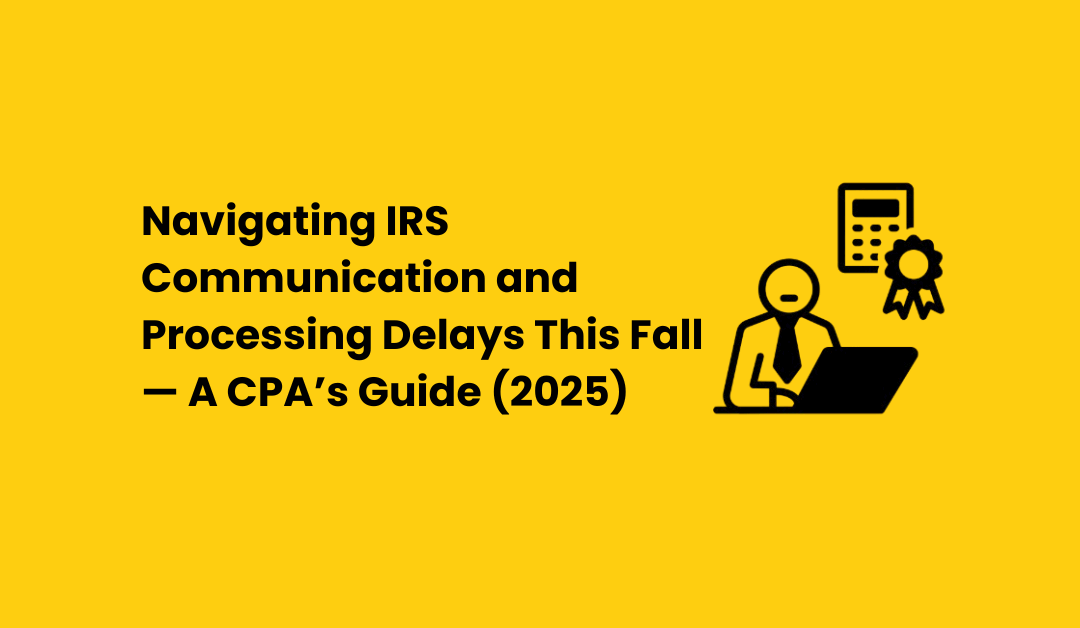As we move into the fall of 2025, CPAs are once again facing a familiar challenge: IRS processing delays and communication bottlenecks. Whether you’re working on extensions, amended returns, or clients with identity verification issues, the lag in IRS responses can strain your practice’s timeline—and your sanity.
What’s Causing the Delays?
- Pending E-payments & False “Balance Due” Notices
Earlier this year, the IRS acknowledged delays in processing some electronic payments, resulting in erroneous balance-due notices for payments already made. Taxpayers who paid on time may see pending status notices—but if the payment doesn’t clear by mid-July, calls to the IRS may be needed. - Amended Returns, Identity Theft, and Paper Filings
The IRS continues to be overwhelmed with amended returns, identity theft victim assistance (IDTVA) cases, and paper correspondence. A Taxpayer Advocate report revealed that, through April 18, 2025, nearly 3.4 million returns were suspended due to errors or identity concerns. IDTVA resolution now averages a staggering 602 days. - Paper-Based Processing & Postal Delays
Paper returns and correspondence are taking much longer—processing can now stretch up to 16 weeks, especially for amended returns. - Difficulty Reaching the IRS
Despite improvements in hotlines—the Practitioner Priority Service (PPS) improved its response rates significantly this year—overall phone wait times remain high. Staffing reductions, deferred resignations, and layoffs have strained IRS operations, with many fearing these challenges will grow worse in 2026. - Tax Professional Advocacy for Smarter Communication
The Texas Society of CPAs and others are urging the IRS to delay sending certain notices, improve secure communication tools, and better sync postal mailing timelines to prevent unnecessary confusion.
How Should CPAs Adapt This Fall?
1. Stay Ahead with Proactive Monitoring
- Encourage clients to consistently check their IRS Online Accounts—this is more reliable than waiting for notices by mail.
- Watch for pending statuses on e-payments and advise clients accordingly, especially around the mid-July mark.
2. Prioritize Electronic Channels
- Use electronic filing and direct deposit whenever possible. They remain the fastest routes to refunds—typically within 21 days for e-filed returns without complications.
- For amended or paper filings, set expectations that processing may take 4–16 weeks.
3. Manage Communications Proactively
- Don’t wait for IRS notices—initiate contact, especially for high-risk cases (e.g., identity verification or complex amendments).
- Leverage PPS for prioritized assistance when needed.
4. Set Clear Client Expectations
- Educate clients proactively about delays and what they can—or can’t—control.
- Clarify average waiting times, especially for IDTVA cases—now averaging nearly 20 months.
Hive Tax AI: Your Strategic Ally This Fall
In the face of IRS backlogs and modern-day inefficiencies, Hive Tax AI offers powerful support to CPAs:
- Instant Research & Planning: Hive Tax AI surfaces relevant IRS notice guidance, resolution steps, and processing timelines—so you can advise clients swiftly and accurately.
- Smart Alerting: Its tools flag cases with elevated risk of delays (e.g., amended returns, identity issues), allowing you to schedule timely follow-ups or escalate as needed.
- Template-Based Communication: Use Hive to generate tailored client communications—explaining IRS delays, next steps, and when to anticipate outcomes.
- Workflow Automation: Automate tasks like checking IRS account statuses or drafting responses to common notice scenarios—cutting administrative drag so you can focus on client strategy.
Together, these capabilities let you stay one step ahead—providing clarity to clients, reducing manual burdens, and turning uncertainty into confidence.
Summary Table: Delay Drivers & CPA Responses
| IRS Delay Source | CPA Action | Hive Tax AI Advantage |
| E-payment processing delays | Monitor IRS account; preempt erroneous notices | Alerts and status tracking |
| Amended/Identity/Paper processing | Set client expectations; initiate early follow-up | Risk-based task scheduling |
| IRS phone line staffing | Use PPS; communicate proactively | Guidance for phone scripts and escalation paths |
| Postal/Notice timing issues | Track mail timelines; advise caution with response deadlines | Notice draft templates and delay-aware messaging |
| Complex or flagged cases | Engage proactively; plan over 12+ months if needed | Case timelines and client communication aids |
Final Word for CPAs This Fall
Fall 2025 tax season is shaping up to extend well beyond standard timelines. With persistent delays across payments, amended returns, identity reviews, and correspondence, your clients need clarity and trust more than ever. Combine that with proactive communication, realistic planning, and the efficiency-boosting power of Hive Tax AI, and you’ll deliver service that’s both thoughtful and timely.
Ready to elevate your fall workflow? See how our AI tax tool AI tax research and AI tax planning tools can elevate your practice?

